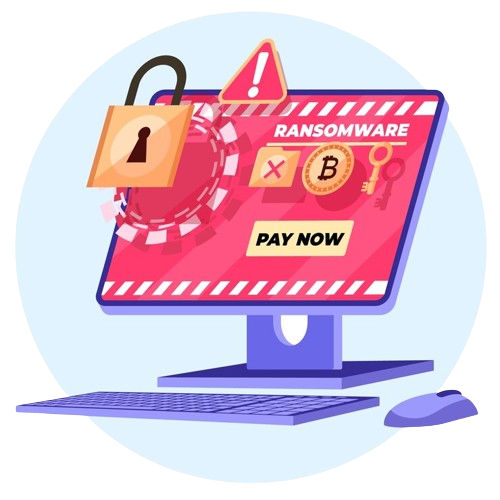RANSOMWARE PROTECTION SERVICE

A ransomware attack is an attack carried out with malware that encrypts your systems and data. Attackers demand a
ransom to decrypt your data, allowing you to access it again. Often, attackers ask for payment in cryptocurrency
since it is anonymous and less traceable. The ransoms demanded can be minor or can be for large sums of money.
Our Ransomware Solutions:
How ransomware infects a system or device
- Phishing emails and other social engineering attacks: Phishing emails manipulate users into downloading and running a malicious attachment (which contains the ransomware disguised as a harmless looking .pdf, Microsoft Word document, or other file), or into visiting a malicious website that passes the ransomware through the user’s web browser.
- Operating system and software vulnerabilities: Cybercriminals often exploit existing vulnerabilities to inject malicious code into a device or network. Zero-day vulnerabilities, which are vulnerabilities either unknown to the security community or identified but not yet patched, pose a particular threat. Some ransomware gangs buy information on zero-day flaws from other hackers to plan their attacks. Hackers have also effectively used patched vulnerabilities as attack vectors, as was the case in the 2017 WannaCry attack discussed below.
- Credential theft: Cybercriminals may steal authorized users' credentials, buy them on the dark web, or crack them through brute force. They may then use these credentials to log into a network or computer and deploy ransomware directly. Remote desktop protocol (RDP), a proprietary protocol developed by Microsoft to allow users to access a computer remotely, is a popular credential-theft target among ransomware attackers.
- Other malware: Hackers often use malware developed for other attacks to deliver a ransomware to a device. The Trickbot trojan, for example, originally designed to steal banking credentials, was used to spread the ransomware variant throughout 2020-21.
- Drive-by downloads: Hackers can use web sites to pass ransomware to devices without the users’ knowledge. Exploit kits use compromised web sites to scan visitors’ browsers for web application vulnerabilities they can use to inject ransomware onto the device. Malvertising—legitimate digital ads that have been compromised by hackers—can pass ransomware to devices, even if the user doesn’t click the ad.
